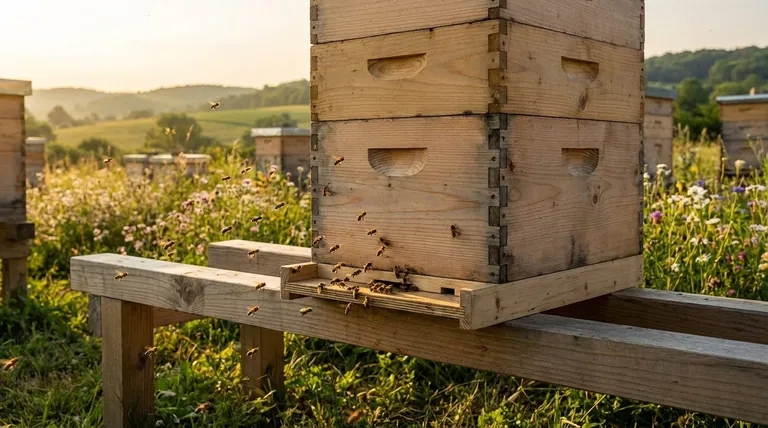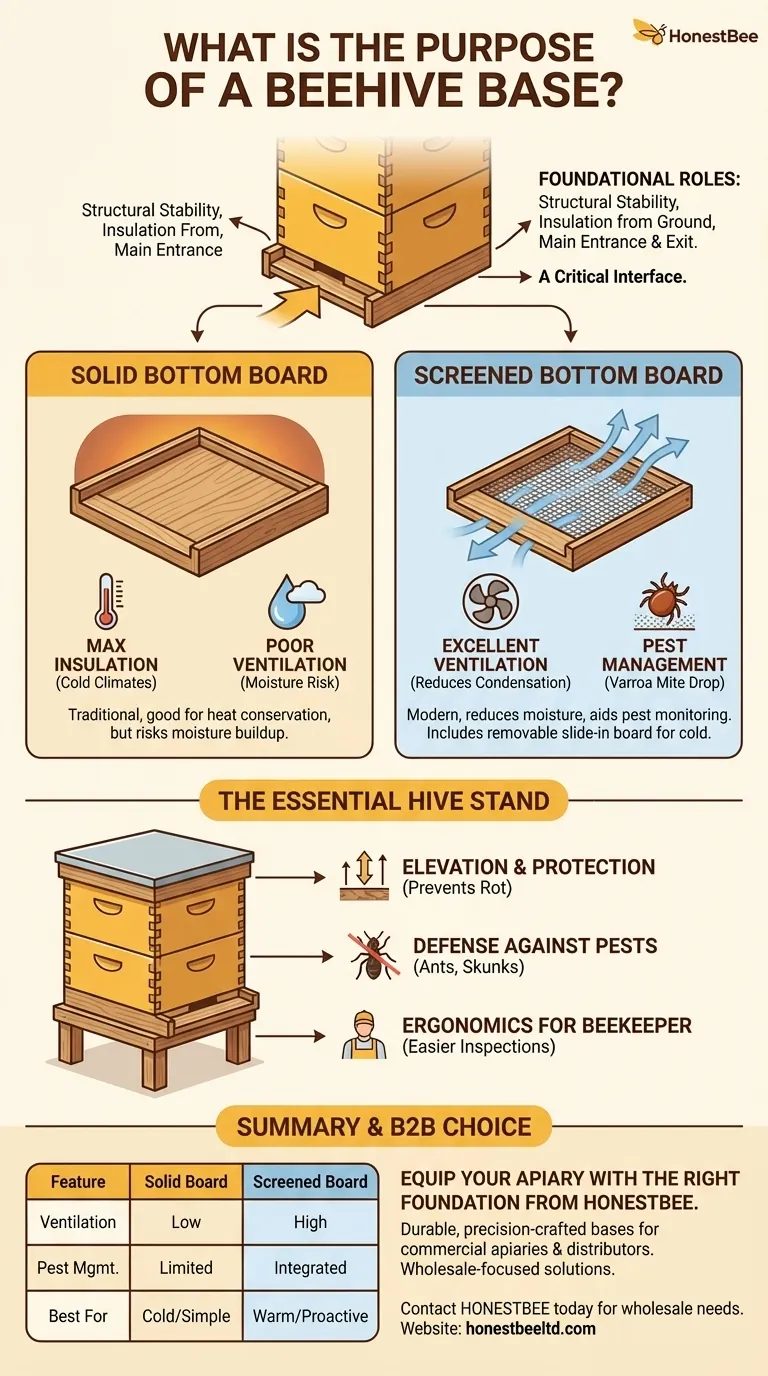At its core, a beehive base serves as the foundational floor of the hive. It provides structural stability, insulates the colony from the damp ground, and creates the primary entrance and exit for the bees. It is the critical interface between the controlled environment inside the hive and the world outside.
The beehive base, or bottom board, is far more than a simple floor. It is a strategic component that directly influences the colony's thermoregulation, defense, ventilation, and overall health.

The Foundational Roles of the Beehive Base
While it may seem like a simple plank of wood, the bottom board performs several essential functions that are vital for a thriving colony. Understanding these roles is the first step toward effective hive management.
Structural Foundation and Stability
The bottom board is the literal foundation upon which all other hive components—the hive bodies and honey supers—are stacked.
It provides a solid, level surface that ensures the entire structure remains stable. An unstable base can lead to precarious stacks, making inspections difficult and dangerous.
Creating the Hive Entrance
The bottom board is designed to create a specific gap when the first hive body is placed on top of it. This gap serves as the main entrance and landing board for the entire colony.
This entrance is the colony's front door, used by foragers for all their flights and by guard bees to defend the hive against intruders.
Insulation from the Ground
Placing a hive directly on the earth would expose the colony to constant dampness and cold, forcing the bees to expend enormous energy to maintain the required internal temperature.
The base lifts the colony off the ground, providing crucial thermal insulation. This helps keep the brood nest warm in the winter and prevents moisture from wicking up into the hive.
Understanding the Trade-offs: Solid vs. Screened Bottom Boards
The most significant decision regarding a hive base is the choice between a traditional solid board and a modern screened board. Each has distinct advantages and disadvantages.
The Solid Bottom Board
A solid bottom board is a simple, flat piece of wood. This is the traditional design that has been used for centuries.
It offers maximum insulation from below, which can be beneficial for conserving heat in very cold climates. However, it provides poor ventilation, which can lead to excess moisture buildup—a major contributor to winter colony loss.
The Screened Bottom Board
A screened bottom board replaces a portion of the solid wood with a durable wire screen (typically 8-mesh hardware cloth).
This design provides excellent year-round ventilation, significantly reducing condensation inside the hive. It also serves as a critical tool for pest management, as Varroa mites that fall off bees will drop through the screen and out of the hive, allowing for easy monitoring. In cold winters, a removable slide-in board can be inserted to reduce drafts.
The Role of the Hive Stand
While the bottom board is the hive's floor, the hive stand is what the entire structure rests on. It is a separate but essential component of the complete hive base system.
Elevation and Protection
A hive stand elevates the bottom board several inches or more off the ground. This protects the wooden components from rot and decay by keeping them away from ground moisture and vegetation.
Defense Against Pests
Lifting the hive makes it more difficult for crawling pests like ants to gain access. It also provides a crucial buffer against larger predators, such as skunks, which disturb hives by scratching at the entrance.
Ergonomics for the Beekeeper
A raised hive is significantly easier and more comfortable to inspect. By bringing the hive up to a more manageable height, a stand reduces the back strain associated with lifting heavy honey supers.
Making the Right Choice for Your Apiary
Your choice of hive base should be a deliberate decision based on your climate, management style, and goals.
- If your primary focus is cold climate insulation and simplicity: A solid bottom board on a sturdy stand is a reliable, traditional choice.
- If your primary focus is pest management and ventilation: A screened bottom board offers superior airflow and an integrated method for monitoring and controlling Varroa mites.
- If your primary focus is hive longevity and beekeeper comfort: Elevating any hive base on a dedicated hive stand is the best practice for protecting both your equipment and your back.
Ultimately, the right hive base is a strategic tool that helps you create a healthy, productive, and easy-to-manage apiary.
Summary Table:
| Function | Solid Bottom Board | Screened Bottom Board |
|---|---|---|
| Primary Advantage | Superior insulation in cold climates | Excellent ventilation & pest control |
| Ventilation | Low (can lead to moisture buildup) | High (reduces condensation) |
| Pest Management | Limited | Integrated Varroa mite monitoring & control |
| Best For | Cold climates, simplicity | Warm/humid climates, proactive management |
Equip Your Apiary with the Right Foundation from HONESTBEE
Choosing the correct beehive base is a critical decision for hive health and productivity. Whether you manage a few hives or a large commercial apiary, the right equipment is the foundation of your success.
HONESTBEE supplies durable, precision-crafted beehive bases and bottom boards—including solid and screened options—to commercial apiaries and beekeeping equipment distributors. Our wholesale-focused operations ensure you get the reliable, high-volume supplies you need to support thriving colonies and efficient hive management.
Ready to build a stronger foundation for your beekeeping operation? Contact HONESTBEE today to discuss your wholesale equipment needs and how our solutions can contribute to your apiary's health and profitability.
Visual Guide

Related Products
- Langstroth Solid Bottom Board for Beekeeping
- Professional Ant-Proof Beehive Stand with Integrated Moat for Beekeeping
- Plastic Bee Hive Stand for Beekeeping
- Wholesales Dadant Size Wooden Bee Hives for Beekeeping
- Langstroth Screen Bottom Board for Beekeeping Wholesale
People Also Ask
- How is the solid bottom board constructed to ensure durability? Built for Longevity with Quality Wood & Beeswax
- What are the characteristics of a solid bottom board? A Guide to Hive Foundation & Climate Control
- What factors should be considered when choosing between a solid and screened bottom board? Make the Right Choice for Your Hive's Health
- What is the recommended approach for choosing between different types of hive boards if you have multiple hives?
- What is the recommendation for bottom boards in top bar hives? Choose the Right Foundation for Your Climate



















